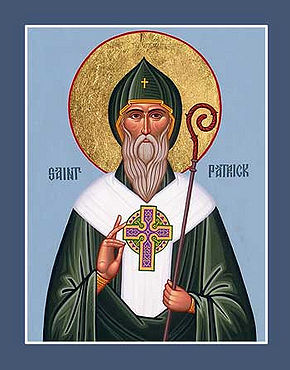Saint Patrick
Saint Patrick (Naomh Pádraig) of Ireland was a Catholic missionary who travelled to Ireland in the early-or-mid 5th Century AD to complete the work of the Bishop Palladius, who had earlier been charged by the Pope with the task of evangelising Ireland. Patrick is believed to have converted virtually the entire island of Ireland to Christianity. Much about him remains a mystery, though some of his personal writings have survived.
Contents
Life as a Slave
He was captured as a teenager during a raid on the west coast of Britain (possibly Wales, or perhaps what is now South West Scotland) by an Irish king known as Niall of the Nine Hostages and sold as a slave in Ireland, where he herded animals on Slieve Mish (Sliabh Mis) mountain, near Belfast. After six years of this, he escaped to Gaul (France).
Dream
When Patrick was in his forties, he had a vivid dream that told him to return to Ireland. He wrote in his Confession:[1]
In the depth of the night, I saw a man named Victoricus coming as if from Ireland, with innumerable letters, and he gave me one and while I was reading I thought I heard the voice of those near the western sea call out: 'Please, holy boy, come and walk among us again.' Their cry pierced my very heart, and I could read no more, and so I awoke.
Patrick risked his life by returning to Ireland and attempting to convert the ruling Kings and Chieftains who ruled the island. According to legend, he used the shamrock (seamróg), a small three-leafed plant that resembles a miniature clover to educate the Irish about the Trinity. However, since many of the Irish lready worshiped a Goddess, Brigid, with three forms, it is unlikely that the Irish needed the idea of three parts in one god explained to them.
Conversion
Patrick baptized 120,000 Irish and established 300 churches. According to legend, Patrick banished the snakes from Ireland, as there are no snakes there to this day. Some regard the snakes as a metaphor representing heathen religions.
Reflection and Death
Patrick wrote about his life:
Patrick the sinner, an unlearned man to be sure. None should ever say that it was my ignorance that accomplished any small thing, it was the gift of God.
He is believed to have died on March 17, 461 AD, the day celebrated as his birthday.
Image and memory
As Ireland's best-known saint, Patrick became a contested figure during the Reformation and Counter-Reformation, with various factions trying to use him to validate their claims. Protestants and Catholics both claimed him as the founder of their church in Ireland. Counter-Reformation leaders also had to battle the venerable image of Patrick as a miracle-working, Moses-like prophet in order to make him into the model of a devout pastor administering sacraments and encouraging repentance for sins. By the middle of the 17th century he was firmly established as the founder of Catholicism in Ireland. By 1800 Protestants in ireland had also adopted him.
In the United States Irish Catholics made St. Patrick's Day (March 17) an occasion for major celebrations. Today it is widely appreciated as a day for parades and drinking salutes and the wearing of the green.
Further reading
- Philip Freeman. St. Patrick of Ireland (2004) 216pp excerpt and text search
- William Bullen Morris. The life of Saint Patrick, apostle of Ireland (1890) 303pp full text online, old study
- Thomas O'Loughlin. Discovering Saint Patrick (2005) 254 pages excerpt and text search
- E. A. Thompson. Who was Saint Patrick? (1999) 190 pages excerpt and text search
References
- ↑ American Minute for March 17th
